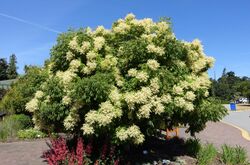Biology:Meliosma oldhamii
| Meliosma oldhamii | |
|---|---|

| |
| Scientific classification | |
| Kingdom: | Plantae |
| Clade: | Tracheophytes |
| Clade: | Angiosperms |
| Clade: | Eudicots |
| Order: | Proteales |
| Family: | Sabiaceae |
| Genus: | Meliosma |
| Species: | M. oldhamii
|
| Binomial name | |
| Meliosma oldhamii Miq.
| |
Meliosma oldhamii is a species of deciduous tree in the Sabiaceae family, which grows up to 20 meters in height. It has a narrow crown when young, and it becomes more wide-spreading with age. It is endemic to China , Japan , and Korea.
Description
Its leaves are odd-pinnate, coriaceous, 15–50 cm long, comprising 9-17 leaflets, each of which is 3–15 cm long by 1–5 cm wide, and ovate to elliptic-lanceolate in shape.
Habitat
It grows in a variety of habitats, but is dominant within forests such as valley forests or mountain forests. It can also be found growing within mountain slopes that have a humid temperature. It is found at elevations ranging from 300 to 1,900 meters.[1]
Cultivation
M. oldhamii thrives in temperatures which are mildly hot to hot. It's incapable of surviving cold temperatures. The plant can survive -15 degrees Celsius.[1]
The pollen of M. oldhamii reaches maturity which then causes the cells within the anther to burst and expel all their pollen while the flower still hasn't grown to maturity yet. Even though the anther cells burst releasing pollen, it remains within the cavities of the staminodes. Pollen remains trapped within such cavities until the bud has matured fully and is ready to bloom. Then the bud explodes, releasing the pollen into the air which is then moved around naturally to pollinate other plants. When the flowers finally bloom within this plant, the petals and stamens fall off since their only job is to allow the pollen to be distributed. Therefore, most of the times when observing a mature M. oldhamii plant it's observed that only buds are found since the flowers drop off.[1]
Uses
The plants leaves can be cooked and eaten.[citation needed] The wood of the M. oldhamii used to create small day to day objects such as boxes. The wood can also be used as a fuel source for fires. The wood has no commercial use because it's not strong. [1]
References
- Miquel ex Maximowicz, Mélanges Biol. Bull. Phys.-Math. Acad. Imp. Sci. Saint-Pétersbourg. 6: 263. 1868.
- Flora of China
- University of Ulm
Wikidata ☰ Q15240270 entry
 |

